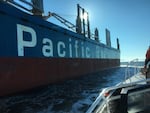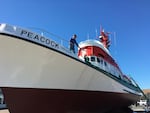Imagine a stretch of water so dangerous even huge ships can’t cross it safely. A place sailors call the “graveyard,” where hundreds of boats have sunk and thousands of people have drowned.
Now imagine this place is crucial to the global economy, and like it or not, shipping vessels must enter it every day to keep things moving and avoid economic collapse.
Such a place exists in the Pacific Northwest. The Columbia River Bar, located at the intersection of the Columbia River and the Pacific Ocean, is considered one of the most dangerous stretches of water in the world.
In order to keep shipping vessels moving in and out of its depths, expert pilots wait at the mouth of the river to board the ships and steer them to safety.
“They don’t call this the graveyard of the Pacific just to be funny,” Captain George Waer told OPB. “
Adds Captain Dan Jordan, "Every time we go to work there’s a real risk.”

Columbia River Bar pilots board huge shipping vessels to help them cross the treacherous water safely.
Ed Jahn / OPB
The Columbia River Bar is highly trafficked despite this risk—ships pass through it upwards of 10 times each day hauling more than $24 billion in goods each year. That’s why, rain or shine, the pilots must travel out to the vessels and guide them to their destination.
If crossing the water in a shipping vessel is dangerous, crossing it in a rowboat is far more so. But that’s what these pilots did for nearly a century, rowing out to the ships and boarding them using a rope ladder. They did so at the order of Captain George Flavel, who in the mid-1800s began promoting his most experienced shipmasters to the title of Columbia River Bar Pilots, a practice still in place today.
It wasn’t until 1967 that a diesel-powered solution to the rowboat came along. The Peacock was a round-bottomed vessel with a “daughter boat” strapped to its deck. When a ship entered the bar, a pilot drove the Peacock out into the water and launched the daughter boat toward it, saving himself the effort and risk of rowing out onto the bar. To return, however, he had to power the daughter back to the Peacock—sometimes braving 25-foot swells in the process—and haul it back on to the deck.

The Peacock can now be found at the Columbia Maritime Museum in Astoria.
Ed Jahn / OPB
The Peacock saved many lives in the Columbia River Bar, but it was a noisy (and still quite risky) way to travel. Today it sits proudly in front of the Columbia Maritime Museum in Astoria, and more often than not the Columbia River Bar Pilots can be seen not on the water but flying through the air: in a helicopter.
Though the helicopter is a much safer way to traverse the choppy waters, the bar pilots still risk their lives each day to keep ships moving in and out of the Columbia River Bar.
“A bar pilot can never be wrong,” says Waer, noting that a mistake can cost the economy billions of dollars, not to mention the lives that might be lost if a ship capsizes.
“It’s terrifying,” he adds, “but it’s the most satisfying job in the world.”
See more of these pilots at work in the next episode of "Oregon Field Guide," Thursday, Oct. 20, at 8:30 p.m. on OPB TV.